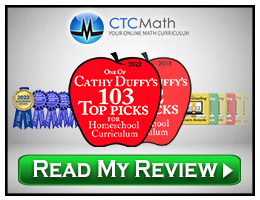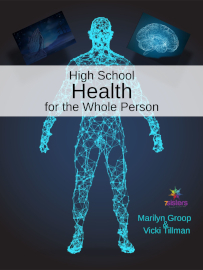High School Health for the Whole Person, written for Christian students, covers basic anatomy and physiology, nutrition and exercise, mental and spiritual health, and injuries and disease (including treatment and prevention). The introduction to the course begins by saying, “Humans, male and female, are created in the image of God. As such we are not just physical beings. Whole person health requires us to nourish every part of our being - body, mind, soul, and spirit. Since we are also the temple of the Holy Spirit, we owe it to God as well as ourselves to care for that temple.”
The course can be used for varying levels of credit, although all students should usually take two semesters to complete the course. To be considered a college prep, Advanced, or Honors course, students need to also complete a CPR and First Aid course available through the Red Cross, the American Heart Association, or other local providers. Those working toward Advanced or Honors level credit will add enrichment exercises and assignments as explained in the Introduction.
The course is sold as three digital components: the student textbook, tests, and answer key. You can also download the three-page suggested course syllabus for free. Optional video lessons are available, and I describe them below.
The textbook includes some full-color illustrations and is arranged in two parts, with 21 chapters in the first part that focus on physical health and nine in the second part that cover mental, emotional, and spiritual health.
Part 1 teaches about body systems as the foundation for understanding proper functioning as well as disorders. For example, the first chapter teaches about the five senses, then the second chapter discusses disorders of the senses such as cataracts, ear infections, deafness, allergies, and other such issues. Continuing in this two-chapter-per-topic fashion, the first part covers the skin, the musculoskeletal system, the cardiovascular and respiratory systems, the nervous system, the digestive and urinary systems, nutrition, the lymphatic and immune systems, the reproductive system, and fetal development and childbirth. Each of these chapters is followed by a chapter on disorders. The first part of the textbook concludes with a chapter on the “Health Benefits of Exercise.” Note that the chapter on reproduction presents a limited description of the sex act and states that it should be “reserved for marriage.”
The second part of the textbook begins with a chapter on the brain, followed by one on disorders of brain functions. The third chapter on emotional wellness is followed by three related chapters on emotional and mental health problems, help and treatment for such problems, and self-care. The seventh chapter, titled “Self & Social Awareness for Health & Safety,” is followed by a chapter on healthy relationships that includes a discussion of healthy interactions with friends, organizations, and in the workplace. The final chapter discusses caffeine, tobacco, alcohol, drugs, and pornography.
Every chapter concludes with optional Enrichment activities, Teacher Resources, and questions. Enrichment activities include researching and writing a paper, creating a model (from clay or other resources), demonstrating or performing healthy activities, drawing a model, writing in a gratitude journal, playing with interactive brains (online), and writing a narrative about a positive interaction. Teacher Resources are hyperlinked lists of YouTube® videos that support the chapter material. While watching all the videos is not required, they make the course more interesting. Most of the questions check for comprehension, but a few, especially in the second part, require more personal answers. For instance, the twelfth question for Part 2: Chapter 1 says, “Give an example from the text or your own life experiences of the body affecting the mind/brain,” and the seventh question for Section 2: Chapter 3 asks, “What are the ways you most prefer to connect with God?”
While this is not a comprehensive human anatomy course, it does introduce students to some anatomy and its accompanying vocabulary. Students are asked questions such as “What are the three main parts of the ear and what is the function of each?” (Part 1, p. 13) and “Name six neurotransmitters and explain what they do.” (Part 2, p. 10).
All but two of the tests cover two chapters each, with exceptions for single-chapter tests for the last chapter of each part of the textbook. The tests present various types of questions: matching, fill-in-the-blank, multiple-choice, and sentence or paragraph responses. One question asks students to show blood flow on a heart diagram.
The answer key has answers for all textbook and test questions, except the rare personal questions for which students’ answers will vary.
The course should work well for independent study, but there are suggestions on the publisher’s website for those who want to use it with a group class.
Video Lessons
The optional video instruction for High School Health for the Whole Person is presented by the textbook authors Marilyn Groop and Vicki Tillman. They teach by reading through the textbook, illustrating lessons with many more images than are in the textbook.
Students still need the separate textbook, tests, and answer key. While the textbook chapters are displayed online below the videos, the videos cannot be viewed while reading beyond the first part of each online chapter. Consequently, students who want to read along will likely do so with the separate textbook. They also need the textbook for chapter questions. Suggested enrichment activities are found in both the online textbook chapters and the separate textbook.
Both the textbook and the video lessons include optional video links at the end of chapters, under the heading “Teacher Resources” in the separate textbook. The first video lesson inserts those links after topics rather than at the end of the chapter, but otherwise, the content of both online and separate textbooks is almost the same, including illustrations.
Part 1 of the course is taught by Marilyn Groop with one video per chapter. The longest video in Part 1 runs about 27 minutes and a few run about five or six minutes. Groop sticks closely to the script of the textbook.
Part 2 is taught by Vicki Tillman, and she teaches the chapters in three or more shorter videos rather than a complete chapter per video. Even so, some of the videos still run close to 25 minutes, while others run closer to 10 to 15 minutes. Tillman doesn’t stick as closely to the textbook script, often expanding upon topics and adding introductions, such as a trigger warning about an upcoming discussion of suicide that students can skip. Her more natural manner of presentation takes a little longer but is more appealing.
Tests and answer keys are not online, and parents need to administer tests.
The videos provide some additional information through the extra images, and more importantly, students experience being taught by actual teachers rather than just working through the textbook on their own.
Summary
High School Health for the Whole Person provides solid coverage of health. And it’s a safe choice for parents who want their children protected from prurient information, who want support for their beliefs in sexual abstinence until marriage, and who want to stress the importance of healthy choices regarding both bodily health and relationships.








